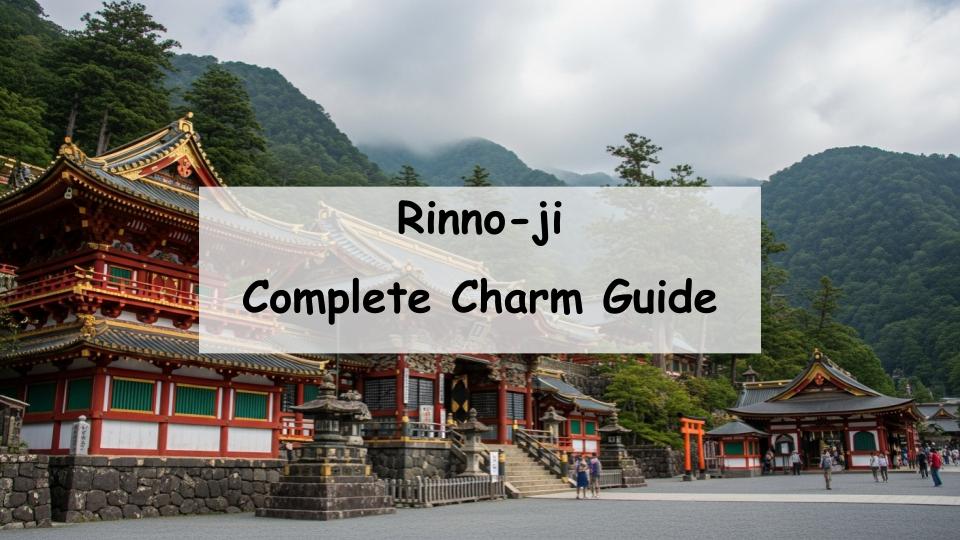Are you wondering, “What kind of temple is Nikko-san Rinnoji?” or “How is it different from Toshogu Shrine and Futarasan Shrine?” and “What are the must-see spots?”
In short, Rinnoji Temple is one of the main temples of the Tendai sect, standing alongside Toshogu and Futarasan Shrines as one of Nikko’s most important religious sites. It houses numerous national treasures and important cultural properties. Its majestic buildings and beautiful grounds harmonized with nature offer a valuable experience combining history, culture, and nature.
In this article, we will introduce Rinnoji’s rich history, architecture, must-see highlights, and practical information including access and suggested sightseeing routes. If you’re planning a trip to Nikko, be sure to read on.
What Is Rinnoji Temple? History and Basic Information
The Founding and Sect of Rinnoji Temple
Rinnoji Temple belongs to the Tendai sect and traces its origins back to the Nara period. It has long served as the religious center of the entire Nikko mountain area, evolving over centuries under the influence of Shugendo and other traditions.
Religious Role and Position of Nikko-san
Rinnoji is one of the three main religious sites in Nikko, along with Toshogu and Futarasan Shrine. It functions not only as a temple but also as a spiritual hub for the region, attracting many worshippers. It holds significant political and cultural importance historically.
Main Buildings and Structure of Rinnoji
Rinnoji’s complex includes the main hall, Sanbutsudo (Hall of Three Buddha), and Goma Hall among others. Many of these buildings are designated national treasures or important cultural properties, featuring majestic architecture blending beautifully with the natural surroundings.
Detailed Introduction to Rinnoji’s Highlights
Features and Viewing Points of the Main Hall and Sanbutsudo
The main hall impresses visitors with its grand wooden construction and solemn presence. Sanbutsudo enshrines sacred Buddha statues that are rarely shown to the public. Both buildings exemplify exquisite craftsmanship and deep historical significance.
National Treasures and Important Cultural Properties
Many of Rinnoji’s buildings are nationally designated treasures or cultural properties, preserving the architectural styles from the Edo period. Careful restoration has maintained their original grandeur, showcasing traditional techniques and artistic excellence.
Gardens and Natural Environment
The temple gardens offer stunning seasonal views that soothe visitors. Designed to harmonize with the mountainous landscape, the gardens shine particularly during spring’s fresh greenery and autumn’s vibrant foliage, making them ideal for peaceful strolls.
Rinnoji’s Cultural Assets and Historical Value
Notable Buddhist Statues and Paintings
Rinnoji houses numerous significant Buddhist statues and paintings. The Buddha statues in Sanbutsudo are especially revered as national treasures, reflecting sophisticated sculpting skills and profound religious meaning. These works are key examples of Japanese Buddhist art.
Historical Anecdotes and Connections with Prominent Figures
Rinnoji has been associated with many important monks and historical figures, including connections to the Tokugawa shogunate. These stories enrich the temple’s legacy and highlight its role in Japan’s religious and cultural history.
Treasures and Exhibition Facilities
The temple’s treasure hall displays valuable calligraphy, Buddhist artworks, and historical documents. These exhibitions offer visitors an opportunity to deepen their understanding and appreciation of Rinnoji’s religious and artistic heritage.
Annual Events and Festivals at Rinnoji
Seasonal Festivals and Rituals
Rinnoji hosts numerous festivals and ceremonies throughout the year. Events during Obon (summer) and Higan (autumn equinox) attract many worshippers and reflect longstanding local traditions, creating a spiritual atmosphere filled with reverence.
Special Exhibitions and Limited-Time Events
Several times a year, Rinnoji opens usually closed halls and displays rare artifacts in special exhibitions. These limited events offer visitors a unique chance to experience the temple’s hidden treasures and deepen their connection to its history.
Popular Ceremonies and Their Significance
The temple’s ceremonies hold great spiritual meaning for worshippers, serving purposes such as warding off evil and praying for good fortune. These rituals preserve ancient customs and continue to be central to the local faith community.
Access to Rinnoji and Nearby Sightseeing Information
Getting There by Public Transportation
Rinnoji is accessible by bus or on foot from JR Nikko Station and Tobu Nikko Station. Clear signage ensures visitors can easily find their way, making it convenient even for first-time travelers.
Access by Car and Parking Information
By car, Rinnoji is just a few minutes from the Nikko-Utsunomiya Road exit. The temple provides parking facilities that accommodate visitors comfortably, even during busy seasons.
Nearby Attractions and Suggested Itineraries
Close to Rinnoji are famous spots like Nikko Toshogu Shrine, Futarasan Shrine, and Kegon Falls. Combining these locations into a day trip lets visitors fully enjoy the rich history and natural beauty of Nikko.
Things to Know Before Visiting Rinnoji
Opening Hours, Fees, and Holidays
Typical opening hours are from 8:00 a.m. to 5:00 p.m. Admission fees vary by facility, so checking the official website for the latest information is recommended. Holidays or special closures may occur depending on events.
Etiquette and Important Notes Within the Grounds
Visitors should maintain quietness, avoid touching statues or cultural properties, and follow staff instructions, especially in restricted areas. Respect for fellow visitors and the sacred space is essential.
Photography Rules and Recommended Spots
While photography is allowed in many outdoor areas, it is restricted inside certain halls and exhibition rooms. The surroundings of Sanbutsudo and the temple gardens are excellent spots for memorable photos.







Comment